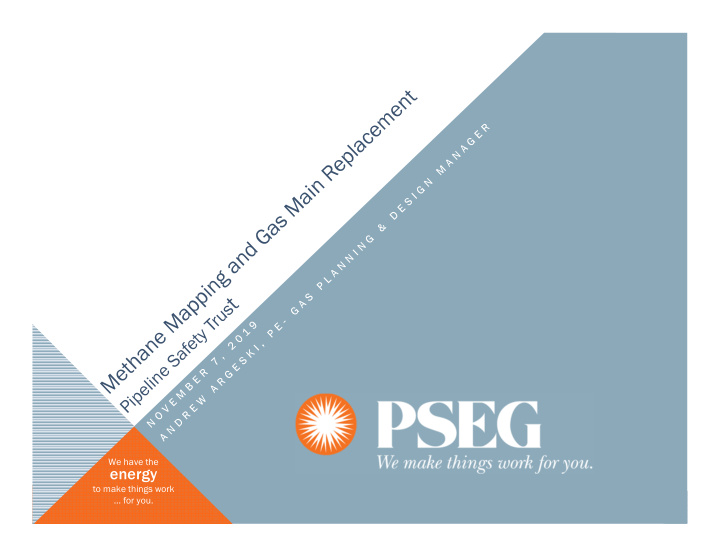



We have the energy to make things work … for you. 1
Getting to know PSE&G Combined electric and gas utility • 6th highest gas utility in US sales • Serves 10 of the top 15 cities in NJ • ~2,400 employees • 17,955 miles of gas distribution main • 57 miles of gas transmission main • 1.2 million gas services • 1.8 million gas customers • Sales volume growth: ~1% per year • 2
PSE&G’s Involvement with Mobile Mapping PSE&G currently operates and maintains one • of the largest inventories of cast iron and unprotected steel gas distribution main at 4,440 miles. PSE&G filed multiple Gas System • Modernization Program (GSMP) filings. Successful support of regulators and other • stakeholders have enabled two large accelerated replacement programs. Supports DOT focus on replacing the highest • risk, most leak prone facilities. Upgrades legacy low (utilization) pressure • systems to medium pressure. Relocates inside meter sets to outside. • Installs excess flow valve (EFV) safety devices. • Total ~170 miles of main replacement per • year over 8 years. 3
Prioritization of Cast Iron Main Replacement Hazard Index (HI) rankings used to express and compare • relative hazard for main segments having a history of breaks. Mileage is based upon total low pressure cast iron mileage in • grid 4
Incorporating Methane Mapping into Prioritization PSE&G partnered with the EDF, Google, and Colorado State University to • perform methane mapping for GSMP I and with Picarro and EDF for GSMP II. A vehicle equipped with state of the art methane and meteorological • sensors was driven repeatedly along streets with cast iron natural gas pipelines targeted for replacement to map emissions 5
Methane Quantification Survey Areas generally require 3 • passes on each side of the street over multiple nights for proper sampling. Indications are run through • an algorithm with wind, vehicle speed, ethane content and other factors to determine leak rates Heat maps can show areas of • high emissions and calculated leak rates 6
Methane Mapping Results Program Program Miles Miles Grids Grids Grids Accelerated Grids Accelerated Program Program Miles Miles Grids Grids Grids Grids Accelerated Accelerated GSMP I 175 30 5 of 6 GSMP II 275 44 6 of 7 TOTAL 450 74 GSMP I GSMP II 7
Methane Mapping Benefits • Hybrid methodology allows a focus on risk reduction while maximizing methane emission reduction • Mains retired earlier than originally planned stop emitting methane faster • GSMP I By accelerating higher emission grids, PSE&G • captured a 37% reduction through the abandonment of 9% of the mileage surveyed. • GSMP II By accelerating higher emission grids, PSE&G • will capture a 41% reduction through the abandonment of 16% of the mileage surveyed. 8
Overall Challenges • Logistic issues with municipalities Permitting, restoration requirements, other construction coordination, paving • moratoriums • Sequencing of the work Disruptions to the public • System Integrity • • Delay in real-time emission data 9
Questions? 10
Recommend
More recommend